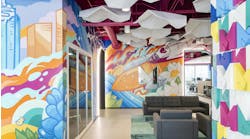Get everyone involved with your redesign from the start.
Major changes with the interiors of your facility can cause tension if not handled correctly. Employees want their workspace to fit their needs, so it’s important that they are included throughout the process.
Lynn Brotman, Associate Principal at Svigals + Partners, an architecture and design firm, presented at NeoCon with Robynne Orr, Project Planner at the Yale School of Medicine and West Campus for the Yale Office of Facilities, about a recent project at Yale Medicine. By engaging with stakeholders at Yale, they successfully made the project harmonious.
Related: Energy Saving Plan: Consider Occupant Comfort
Brotman encourages a creative engagement process, which involves workshops designed to get everyone on the same page. This approach was used at the Yale Child Study Center, as well as other Svigals projects.
Learn how to make sure everyone at your organization is on board with your new interior design.
Creative Engagement Process
Close communication between the client and design team is important to any major interior redesign. The more voices being heard on the side of the client organization helps create a singular vision later in the process.
Hand-picked: How Acoustics Plays a Role in Workplace Health
“All firms do interviews and questionnaires for people’s needs, and the good ones will do vision sessions to find out their hopes and aspirations,” explains Brotman. “We take it a step deeper with creative engagement workshops, and we find that extra step pays off phenomenally.”
The key to these workshops is that you’re involving as many stakeholders as possible. To get started, they get everyone focused with an icebreaker activity that involves some physical element. This helps relieve everyone from the distractions they bring into the process.
“We do these workshops because they bring in everyone that is affected by the project, which creates a sense of purpose and creates bonds with the participants at a humanistic level that breaks down barriers,” says Brotman. “This allows them to get out of a single focus by considering other users in the space, and it gives a platform for people to be heard. Forming this bond is tremendous because in the end you get these ambassadors because people have a general sense of why decisions were made.”
This is especially important for organizations undergoing a culture shift that manifests itself through design. As companies move from private to open offices, for example, this kind of process helps people understand why decisions are being made.
Sister publication - interiors+sources
Designing for the Multi-Generational Workplace
For example, if some people want six huddle rooms and others want eight, the answer that makes the most sense for your facility will fall into place after a conversation involving all parties. Then, if your organization decides to go with six huddle rooms, everyone will understand why there are only six.
Yale Child Study Center
The Yale School of Medicine’s Child Study Center was one such project Brotman worked on, and these workshops were an integral part of the process.
“We used a couple of different ways to get the group on the same page, one of which was having everyone find images of what makes them comfortable and happy,” says Brotman. Because this is a facility for children, many of them used this opportunity to think about what makes kids comfortable.
Trending: How Lighting Can Disinfect Your Facility’s Workspaces
They also asked participants what feeling they wanted people to have when they walked in and then translated those results into a word cloud. This provides a visual representation that people are on the same page and have the same goals.
Overall, this project was a success because those who work in the space had a say in its conception. Much of the credit goes to Orr and the rest of the team at Yale, who made sure employees were involved in the process.
“Facility managers need to support this engagement process and be a champion for it,” says Brotman. They need to assure that people from all different work environments are involved. Just make sure people are listening to each other and their ideas. Things that won’t work eventually fall to the wayside.
“People really just want to be heard, even if what they ask for they don’t get,” adds Brotman.
Justin Feit was associate editor of BUILDINGS.
Brotman and Orr presented the seminar “Creative Engagement for Successful Workplace Planning and Programming” at NeoCon 2018 in Chicago.

